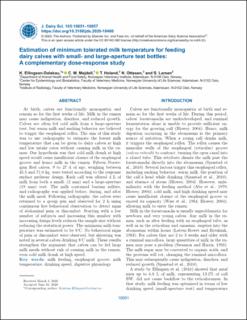| dc.contributor.author | Ellingsen-Dalskau, Kristian | |
| dc.contributor.author | Mejdell, Cecilie Marie | |
| dc.contributor.author | Holand, Trond | |
| dc.contributor.author | Ottesen, Nina | |
| dc.contributor.author | Larsen, Stig | |
| dc.date.accessioned | 2020-11-30T09:07:05Z | |
| dc.date.available | 2020-11-30T09:07:05Z | |
| dc.date.created | 2020-10-16T14:05:42Z | |
| dc.date.issued | 2020 | |
| dc.identifier.citation | Journal of Dairy Science (JDS). 2020, 103(11), 10651-10657. | en_US |
| dc.identifier.issn | 0022-0302 | |
| dc.identifier.uri | https://hdl.handle.net/11250/2690093 | |
| dc.description.abstract | At birth, calves are functionally monogastric and remain so for the first weeks of life. Milk in the rumen may cause indigestion, diarrhea, and reduced growth. Calves are often fed cold milk from a large-aperture teat, but warm milk and sucking behavior are believed to trigger the esophageal reflex. The aim of this study was to use radiography to estimate the lowest milk temperature that can be given to dairy calves at high and low intake rates without causing milk in the rumen. Our hypothesis was that cold milk drunk at high speed would cause insufficient closure of the esophageal groove and hence milk in the rumen. Fifteen Norwegian Red calves, 9 to 27 d of age, weighing between 45.5 and 71.0 kg, were tested according to the response surface pathway design. Each calf was offered 4 L of milk from both a small- (2 mm) and a large-aperture (19 mm) teat. The milk contained barium sulfate, and radiography was applied before, during, and after the milk meal. Following radiography, the calves were returned to a group pen and observed for 2 h using continuous live behavioral observation to detect signs of abdominal pain or discomfort. Starting with a low number of subjects and increasing this number with increasing design levels reduces the sample size without reducing the statistical power. The minimum milk temperature was estimated to be 8°C. No behavioral signs of pain or discomfort were observed, but shivering was noted in several calves drinking 8°C milk. These results strengthen the argument that calves can be fed large milk meals without risk of causing milk in the rumen, even cold milk drunk at high speed. | en_US |
| dc.language.iso | eng | en_US |
| dc.rights | Attribution-NonCommercial-NoDerivatives 4.0 Internasjonal | * |
| dc.rights.uri | http://creativecommons.org/licenses/by-nc-nd/4.0/deed.no | * |
| dc.title | Estimation of minimum tolerated milk temperature for feeding dairy calves with small- and large-aperture teat bottles: A complementary dose-response study | en_US |
| dc.type | Peer reviewed | en_US |
| dc.type | Journal article | en_US |
| dc.description.version | publishedVersion | en_US |
| dc.source.pagenumber | 10651-10657 | en_US |
| dc.source.volume | 103 | en_US |
| dc.source.journal | Journal of Dairy Science (JDS) | en_US |
| dc.source.issue | 11 | en_US |
| dc.identifier.doi | 10.3168/jds.2020-18460 | |
| dc.identifier.cristin | 1840189 | |
| dc.relation.project | Norges forskningsråd: 268023 | en_US |
| cristin.ispublished | true | |
| cristin.fulltext | original | |
| cristin.qualitycode | 2 | |

